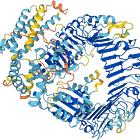Weekly Tech+Bio Highlights #48: Bi-Weekly Overview
AI Protein Design Models, Policy Changes, Industry Funding & Layoffs
Hi! This is
’s weekly newsletter, Where Tech Meets Bio, where we explore technologies, breakthroughs, and cutting-edge companies.If this newsletter is in your inbox, it’s because you subscribed, or someone thought you might enjoy it. In either case, you can subscribe directly by clicking this button:
This issue is sponsored by BiopharmaTrend. BiopharmaTrend delivers pharma and biotech news, industry reports and interviews with key experts, along with technology scouting and market research services, and is exclusively dedicated to exploring the advent of novel technologies in life sciences and all things “tech & bio.”
Join us for Under the Hood: The Real Mechanics of AI in Clinical Development, a virtual mini-conference featuring presentations by industry practitioners, building AI-based solutions for clinical research. September 23, 2025, 5:00 - 7:00 PM CET.
Live demos, focused presentations, and clear-eyed discussion — the event will be hosted by Dr. Louise von Stechow and Dr. Andrii Buvailo, and will feature several practically-oriented presentations by invited industry experts and AI tool builders. You will learn what’s working, what still isn’t, and what’s next.
🤖 AI x Bio
(AI applications in drug discovery, biotech, and healthcare)
🔹 Latent Labs launched web-based AI for protein design—the new tool enables users to generate novel molecules like antibodies using natural language.
🔹 NVIDIA Research, University of Oxford, and Mila – Quebec AI Institute launch La-Proteina, a generative model that creates full atomistic protein structures and sequences up to 800 residues in a single step.
🔹 CB Insights releases 2025 Pharma AI Readiness Index—the report ranks Eli Lilly, Merck KGaA, and Bayer as the top three among 50 pharma companies based on AI execution, innovation, and talent, reflecting an industry-wide shift from planning to large-scale deployment of AI in R&D and operations.
🔹 Isomorphic Labs to begin first human trial of AI-designed drug—DeepMind spinout announced plans to enter clinical testing.
🔹 What’s happening in medical AI—in a recent review published in Cell by Fahrner, Chen, Topol, and Rajpurkar, outlines current uses of generative and multimodal AI in medicine, including LLMs for summarizing notes and supporting clinical decisions, vision-language models for pathology, and forecasting tools for risks like decompensation or post-op complications. Protein structure prediction has expanded into generative design, and AI is being applied to wearables, imaging, and screening. While technical progress is evident, clinical integration remains limited due to regulatory, workflow, and trust challenges.
🔹 Undruggable no more—AI-designed binders hit disordered proteins, unlocking 50% of human proteome; David Baker’s lab at the University of Washington used two AI methods to design binders with nanomolar–picomolar affinity for 39 targets, achieving success in 34 cases.
🔹 Teaching AI to think like a cell—GREmLN, developed by researchers at Columbia, Stanford, and the Chan Zuckerberg Biohub, is a transformer-based foundation model for single-cell genomics that integrates gene regulatory networks to better predict gene interactions and disease origins.
🔹 Shift Bioscience introduces new benchmarking metrics for virtual cell models, showing that common error metrics often favor uninformative mean predictions and obscure biologically relevant signals.
🔹 China researchers debut fully autonomous AI biology lab—researchers at the University of Science and Technology of China unveiled BioMARS, a multi-agent robotic system that uses LLMs, VLMs, and modular robotics to design, execute, and verify experiments without human input, signaling a leap toward 24/7 AI-driven wet labs.
🔹 AI model decodes bacterial evolution—researchers trained a protein language model on 1.3M genomes to predict function, interactions, and traits, offering a new tool for bacterial genomics and synthetic genome design.
🔹 Thousands of hidden viral proteins uncovered—researchers used massively parallel ribosome profiling to identify 4,200 new protein-coding regions across 679 viruses, revealing novel immune targets and translation regulators.
🔹 Researchers introduce a foundation AI model trained on 18 million embryo time-lapse images, which outperforms existing tools in ploidy prediction, embryo quality scoring, segmentation, and staging, offering a non-invasive, standardized solution for IVF embryo assessment.
🔹 AI revealed hidden patient subgroups in trials—NetraMark’s hybrid AI framework combined dynamical systems and LLMs to identify small, high-impact cohorts in clinical studies, improving predictions in cancer and brain disorders.
🔹 Alphabet spinoff SandboxAQ partners with Florida-based iOncologi to develop a high-fidelity mRNA vaccine for glioblastoma, integrating AI-based tools with precision immunotherapy to target this type of aggressive brain cancer.
🔹 Quantum-inspired hardware accelerates reaction optimization—Insilico Medicine used a Digital Annealer Unit to rapidly predict and optimize chemical reaction conditions, matching classical ML accuracy while reducing inference time to seconds.
🔹 ApexOracle AI predicts and designs antibiotics for unknown pathogens—developed at the University of Pennsylvania, the model links pathogen genomes with molecular design to forecast drug efficacy and generate new compounds, aiming to counter antimicrobial resistance in real time.
🔹 OpenAI and Penda Health reported the largest real-world LLM clinical study to date—39,849 patient visits across 15 clinics—showing GPT‑4o cut diagnostic errors by 16%, treatment errors by 13%, and history-taking errors by 32% in live care settings in Kenya.
🔹 Nature of biologics manufacturing is shifting as companies like Resilience and Just–Evotec Biologics adopt continuous processing, cell-free systems, and AI-driven fermentation—cutting costs and timelines, yet most pharma leaders hesitate to act despite knowing disruption is inevitable.
🔹 Reporting in Nature, Memorial Sloan Kettering and Mount Sinai deployed an AI model to predict EGFR mutations from lung biopsies in real time, cutting test turnaround to under 1 hour and reducing molecular testing by 43%.
🔹 Johns Hopkins' AI-powered robot autonomously performed gallbladder surgery with 100% accuracy in simulations (ex vivo models), using voice commands and large language models to adapt in real time.
🔹 Revolution Medicines and Iambic Therapeutics enter a multi-year AI-driven drug discovery collaboration, with Iambic eligible for up to $25M to support discovery efforts using Revolution’s proprietary molecular data.
🔹 MIT-led researchers developed a deep learning tool that integrates cell morphology, location, and molecular data to uncover hidden immune cell subtypes, reported in Nature Immunology.
🔹 Fasikl’s AI-powered neurostimulation wristwatch has received FDA clearance to treat essential tremor, backed by positive trial results, set for limited U.S. rollout in 2025.
This newsletter reaches over 9K industry professionals from leading organizations across the globe. Reserve your sponsor slot in one of the upcoming issues.
Contact us at info@biopharmatrend.com
🚜 Market Movers
(News from established pharma and tech giants)
🔹 AstraZeneca’s $1.3B acquisition of CinCor pays off as baxdrostat succeeds in Phase 3 for uncontrolled hypertension, showing significant BP reduction, strong safety, and potential as a blockbuster alongside Farxiga.
🔹 Sarepta under fire after third gene therapy death—following another patient death tied to liver toxicity, Sarepta faces scrutiny over safety, disclosure practices, and its continued investment in gene therapies, as it restructures, cuts 500 jobs, and shifts focus to RNA-based treatments.
🔹 A bispecific antibody developed using Asimov’s CHO Edge platform has received FDA IND clearance and entered Phase 1 trials, marking the platform’s clinical debut.
💰 Money Flows
(Funding rounds, IPOs, and M&A for startups and smaller companies)
📈 Q2 2025 biotech dealmaking hit $98B in upfront cash/equity, driven by late-stage licensing and M&A like Merck-Verona and Sanofi-Blueprint, even as VC funding fell 33% QoQ to a five-year low and IPOs stalled, according to Endpoints News and DealForma. Licensing deals are the strongest in six years, with big pharma activity notably high in China, signaling a shift toward de-risked assets backed by human data amid a challenging investment climate.
🔹 Roche's Chugai inks a deal worth up to $250M with Gero to develop antibody therapies targeting age-related diseases, using Gero’s AI-driven platform to identify novel targets.
🔹 HSBC data reported by BioPharma Dive show first financings fell from $2.6B to $900M and total venture funding dropped from $7B to $4.8B, hitting a five-quarter low as investor caution deepened.
🔹 A new CBO report estimates that a 10% cut to NIH funding would reduce new drug approvals by ~4.5% (≈2 drugs/year) over 30 years, while a 9-month delay in FDA reviews would eventually cut approvals by ~2% (≈1 drug/year) due to higher development costs.
🔹 AI-driven biotech Recursion acquires full rights to an oral ENPP1 inhibitor for hypophosphatasia from Rallybio for up to $25M in equity and milestones, aiming to begin Phase 1 trials in 2026.
🔹 Sanofi bought Vicebio for $1.15B—the deal adds early-stage non-mRNA RSV vaccines and multi-pathogen candidates.
🔹 Sino Biopharm to acquire LaNova for up to $951M—The deal adds Merck-partnered bispecifics and a broad oncology antibody pipeline, marking a major domestic acquisition in China’s biotech sector.
🔹 Centivax raised a $45M Series A led by Future Ventures to advance its universal flu vaccine into clinical trials within 8 months.
🔹 $20M CRISPR center to fast-track gene editing therapies—The Chan Zuckerberg Initiative is funding a new CRISPR Cures Center at the Innovative Genomics Institute, led by Fyodor Urnov, to develop 8 patient-specific therapies in 3 years by advancing CRISPR as a regulatory platform.
🔹 Zimmer Biomet acquires Monogram Technologies for up to $177M to incorporate Monogram’s hands-free, AI-powered robotic knee surgery system into its Rosa robotics platform, aiming to launch a fully autonomous system with Zimmer’s implants by 2027.
🔹 Merck acquires Verona Pharma for $10B to secure rights to Ohtuvayre, a fast-growing COPD drug with blockbuster potential, as Keytruda and Gardasil near patent expiry.
⚙️ Other Tech
(Innovations across quantum computing, BCIs, gene editing, and more)
🔹 Mini organs grown with their own blood vessels—separate teams (Oscar Abilez, Yifei Miao) reported creating vascularized heart, liver, lung, and gut organoids by coaxing stem cells to form vessels alongside tissues from the earliest stages.
🔹 Cyborg tadpoles enable real-time brain monitoring—Harvard researchers implanted soft, stretchable electrodes into embryos’ neural tissue, allowing single-cell activity tracking throughout early brain development without disrupting normal growth.
🔹 Blackrock Neurotech sponsors the Brain-to-Text ’25 competition, challenging teams to improve speech decoding from intracortical brain signals using a new UC Davis dataset.
🔹 Immunotherapy clears glioblastoma in early trial—UCLH study using ipilimumab before standard treatment showed complete tumor remission in a patient nearly 3 years post-diagnosis, prompting the launch of a new NHS trial for others.
🔹 mRNA vaccine shows promise as universal cancer booster—University of Florida study found that a non-targeted mRNA vaccine enhanced immunotherapy and eliminated tumors in mice, suggesting a new approach for broad, off-the-shelf cancer vaccines.
🔹 Orbital unveils in vivo CAR-T data for autoimmune disease—an RNA-based therapy achieved full B cell depletion in primates, supporting its advancement toward clinical trials in 2026 as a potentially more accessible alternative to traditional CAR-T.
🔹 Researchers in the U.K. reported 8 healthy births using mitochondrial donation (a technique combining DNA from three people) to prevent mothers from passing on rare mitochondrial diseases, as published in NEJM by teams from Newcastle and Monash universities.
🔹 Coherence Neuro joins €11.5M SPARCLE Consortium alongside University of Cambridge, imec, ONWARD Medical, and Salvia BioElectronics to advance miniaturised neural implants for conditions like spinal cord injury, migraine, and cancer, with funding from AENEAS, Xecs_Eureka, and Innovate UK.
🔹 PatentVest's latest report analyzes 28 lesser-known companies developing new surgical robotics platforms, focusing on procedure-specific innovations, IP filings, and regulatory progress, as robotic systems remain used in under 6% of surgeries.
🔹 4Dcell reports a breakthrough in organoid reproducibility, achieving over 95% consistency and reducing loss during medium exchanges to under 12%.
🔹 McMaster researchers have discovered lariocidin, a new class of antibiotics with a novel mode of action effective against drug-resistant bacteria, marking the first such breakthrough in nearly 30 years, as published in Nature.
🔹 ARPA-H launches the FRONT program to restore brain function using regenerative grafts for stroke and injury patients, aiming to reduce long-term care needs and drive U.S. leadership in brain repair technology.
🔹 NYU Langone researchers used an experimental 4-HB treatment to help an 8-year-old boy with a rare genetic disorder, HPDL deficiency, regain the ability to walk—marking a promising bench-to-bedside breakthrough based on NIH-funded biochemical research.
🏛️ Bioeconomy & Society
(News on centers, regulatory updates, and broader biotech ecosystem developments)
🔹 In a major policy shift, the NIH will no longer fund research proposals exclusively involving animals, instead requiring all new funding opportunities to include language supporting nonanimal methods, aligning with its commitment to prioritize human-based research.
🔹 Cradle CEO Stef van Grieken and 44 others called for a 2-year pause on EU AI Act enforcement, citing unclear compliance rules that risk stifling innovation, especially in sectors like bio-AI.
🔹 Tempus AI sued for overstating AI claims—investors filed a securities class action alleging the company exaggerated its AI capabilities and deal value, following a short-seller report and a 20% stock drop.
🔹 Chinese biotechs accounted for 32% of global outlicensing deal value in Q1 2025, up from 21% in 2024, as multinational pharmas turn to lower-cost, first-in-class assets from China to counter pricing pressure and patent cliffs—Jefferies equity research report.
🔹 Anne Wojcicki takes 23andMe nonprofit—newly formed TTAM Research Institute, led by Wojcicki, acquired 23andMe to preserve its mission under a nonprofit model, aiming to expand public access to genetic insights and research.
🔹 Biopharma layoffs jumped 32% year-over-year in H1 2025, with 128 reported rounds amid persistent market pressure, funding cuts, and weak demand.
🔹 David Alderman outlines three regulatory arbitrage strategies—leveraging real-world evidence, orphan drug pathways, and faster international approvals—that align with the FDA’s Advancing RWE Program, urging biopharma companies to treat regulatory strategy as competitive intelligence, not just compliance.
🔹 A Bloomberg analysis shows China has rapidly expanded its biotech footprint, now rivaling the U.S. in drug pipeline volume and surpassing the EU in expedited drug reviews, driven by faster, cheaper clinical trials and growing recognition from top regulators.
🔹 OpenFold adds J&J and Apheris to expand AI-driven biology—the open-source consortium gains new members to advance secure, collaborative model training for drug discovery, combining public AI tools with proprietary data across partners.









